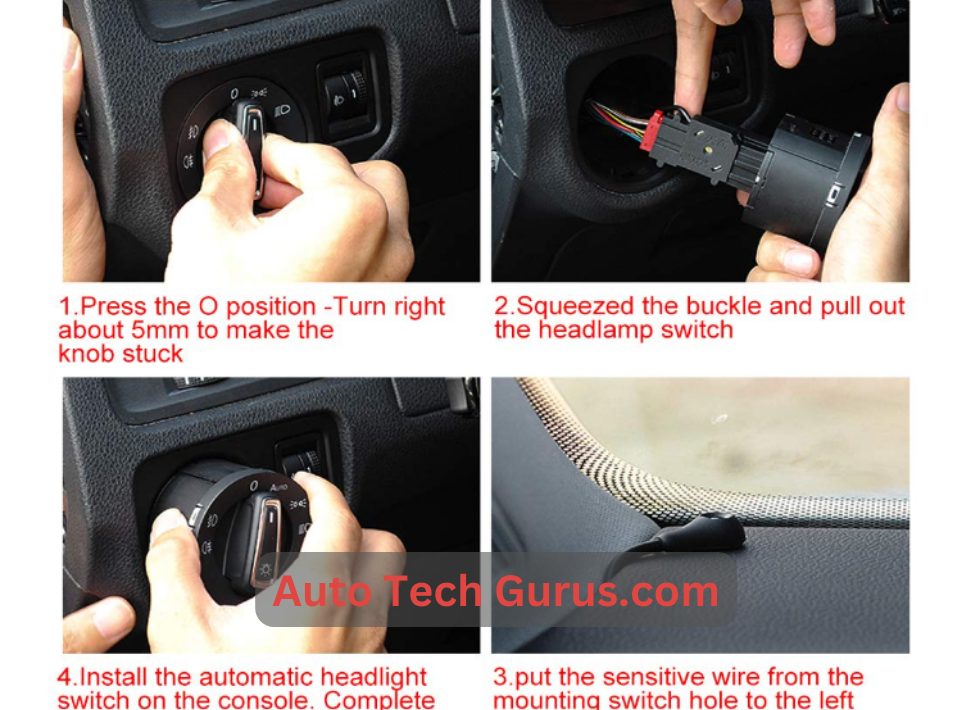How to Install Automatic Headlight Sensor:
A Step-by-Step Guide
Automatic headlight sensors are becoming increasingly popular in modern cars as they provide convenience and safety for drivers. By automatically turning on and off the headlights based on the surrounding light conditions, drivers no longer have to worry about manually adjusting their lights while driving. If you have an older car without this feature, you might wonder how to install an automatic headlight sensor. Fortunately, with the right tools and knowledge, this is a relatively simple process that you can do yourself.

Before you begin the installation process, there are a few things you need to consider. First, ensure you have the right tools for the job, including a wiring diagram for your car, a multimeter, and a soldering iron. You should also choose a suitable location for the headlight sensor, typically on the dashboard or near the rearview mirror. Additionally, you must confirm that your car’s electrical system can handle the extra load from the sensor and control module. Once these factors are in place, you can begin the installation process.
Key Takeaways
- Installing an automatic headlight sensor is a simple process that can be done with the right tools and knowledge.
- Before you begin, ensure you have the right tools and choose a suitable location for the sensor.
- Ensure that your car’s electrical system can handle the additional load from the sensor and control module.
Pre-Installation Preparation
Before installing an automatic headlight sensor, you need to prepare a few things. This section will walk you through the tools and materials you’ll need and some safety precautions to keep in mind.
Tools and Materials Needed
Here are the tools and materials you’ll need to install an automatic headlight sensor:
| Tools | Materials |
|---|---|
| Screwdriver set | Automatic headlight sensor |
| Pliers | Electrical tape |
| Wire cutters/strippers | Wire connectors |
| Crimping tool | Zip ties |
| Multimeter | Electrical grease |
Ensure all the tools and materials are ready before starting the installation process. You don’t want to be halfway through the installation and realize you’re missing a tool or material.
Following these safety tips ensures that the installation process goes smoothly and safely.
Locating the Headlight Sensor

If you’re looking to install an automatic headlight sensor, the first step is to locate the sensor on your vehicle. This section will guide you through identifying the sensor placement and accessing the sensor location.
Identifying Sensor Placement
The automatic headlight sensor is typically located on the dashboard of your vehicle, near the windshield. It may also be located on the rearview mirror. Look for a small, circular lens about the size of a dime.
If you need help locating the sensor, consult your vehicle’s owner’s manual for specific sensor placement information. You can also search online for information on where the automatic headlight sensor is located in your car make and model vehicles.
Accessing the Sensor Location
Once you’ve identified the sensor placement, you must access the sensor location. This may require removing the dashboard or other interior components of your vehicle.
Before you begin, ensure you have the proper tools and equipment. Depending on the make and model of your vehicle, you may need a screwdriver, socket wrenches, or other specialized tools.
Suppose you’re uncomfortable working with automotive components. In that case, it’s best to leave the installation of the automatic headlight sensor to a professional mechanic. They will have the experience and expertise to install the sensor correctly and safely.
In summary, locating the headlight sensor is the first step in installing an automatic headlight sensor. Identify the sensor placement and access the location with the proper tools and equipment. If you’re uncomfortable working with automotive components, leaving the installation to a professional mechanic is best.
Installation Process ( Automatic Headlight Sensor )

Installing an automatic headlight sensor is a simple process that can be done in a few steps. Here are the steps to follow when installing the new sensor.
Removing the Old Sensor
The first step in installing a new automatic headlight sensor is to remove the old one. The old sensor is usually located on the dashboard, near the windshield. To remove it, you must identify the retaining clip holding it. Once you find the clip, press it down and pull the sensor out.
Installing the New Sensor
After removing the old sensor, you can install the new one. The new sensor should come with a retaining clip that you will use to hold it in place. To install the new sensor, align it with the mounting bracket and press it in until you hear a click. It indicates that the clip has engaged and the sensor is securely in place.
Wiring and Connections
Once the new sensor is installed, connect it to the wiring harness. The wiring harness should be located near the sensor mounting bracket. To connect the sensor:
- Match the wires from the sensor to the corresponding wires in the harness.
- A wire stripper is used to strip the wires and connect them using wire connectors.
- Make sure the connections are tight and secure.
After connecting the sensor, you must test it to ensure it works correctly. Turn the ignition on and check if the headlights come on automatically. If they do, then the sensor is working correctly. If they don’t, check the wiring connections and make sure they are correct.
That’s it! You have successfully installed a new automatic headlight sensor.
Testing and Troubleshooting
Once you have installed the automatic headlight sensor, testing it to ensure it works properly is important. Here are some initial testing steps you can follow:
Initial Testing
- Turn on your car and activate the automatic headlights. The headlights should turn on automatically when the ambient light is low.
- Cover the sensor with your hand or a piece of cloth. The headlights should turn on within a few seconds.
- Uncover the sensor. The headlights should turn off within a few seconds.
If the automatic headlights are not working properly, here are some common issues and solutions:
Common Issues and Solutions
- Dirty sensor: It may only work properly if the sensor is clean. Clean the sensor with a soft cloth and some rubbing alcohol.
- Faulty sensor: If the sensor is defective, it may need to be replaced. Refer to the manufacturer’s instructions on how to replace the sensor.
- Electrical issues: If the automatic headlights are still not working properly, your car may have an electrical problem. Check the fuses and wiring to ensure that everything is properly connected.
It is important to troubleshoot any issues with your automatic headlights as soon as possible to ensure that you are always driving safely. By following these testing and troubleshooting steps, you can ensure that your automatic headlights are working properly and providing you with the necessary visibility while driving.
Frequently Asked Questions
What steps are involved in installing an automatic headlight conversion kit?
Installing an automatic headlight conversion kit involves several steps:
- You need to choose a kit that is compatible with your vehicle.
- You need to locate the headlight wiring harness and connect it to the kit’s control module.
- You need to install the light sensor in a location exposed to daylight.
- You need to test the system to ensure that it is working properly.
Can automatic high beams be added to a vehicle that doesn’t have them?
Yes, automatic high beams can be added to a vehicle that doesn’t have them. Several aftermarket kits are available that can be installed to add this feature to your vehicle. These kits typically include a light sensor that detects oncoming traffic and adjusts the headlights accordingly.
What are the best automatic headlight kits available on the market?
Several automatic headlight kits are available on the market, and the best one for you will depend on your specific needs and budget. Some popular options include the Anzo USA Universal Automatic Headlight Conversion Kit and the LASFIT H11/H9/H8/H16 LED Headlight Bulbs.
How can I modify my vehicle to make the headlights turn on automatically?
You will need to install an automatic headlight conversion kit to modify your vehicle to make the headlights turn on automatically. These kits typically include a light sensor that detects the ambient light level and turns the headlights on or off accordingly. You can install the kit yourself or have it by a professional.
How do you properly locate and install an auto-dimming headlight sensor?
To properly locate and install an auto-dimming headlight sensor, consult your vehicle’s owner’s manual for guidance. Generally, the sensor should be installed in a location exposed to daylight, such as on the dashboard or on the windshield. Once you have located the sensor, you can connect it to the control module of your automatic headlight conversion kit.
What is the process for converting manual headlights to automatic operation?
Converting manual headlights to automatic operation involves installing an automatic headlight conversion kit. This kit typically includes a light sensor that detects the ambient light level and turns the headlights on or off accordingly. Locate the headlight wiring harness to install the kit and connect it to its control module. You will also need to install the light sensor in a location exposed to daylight. Once the kit is installed, you can test the system to ensure it works properly.
Conclusion
Installing an automatic headlight sensor is a great way to improve your vehicle’s safety and convenience. With this sensor, you no longer have to worry about turning on your headlights when it gets dark outside, as the sensor will do it for you. Additionally, you’ll be able to save energy and prolong the life of your headlights by using them only when necessary.
Installing an automatic headlight sensor may seem daunting at first. Still, it’s a relatively simple process that can be completed in just a few hours. Following the steps outlined in this article, you can install a sensor that will make your driving experience safer and more convenient.




